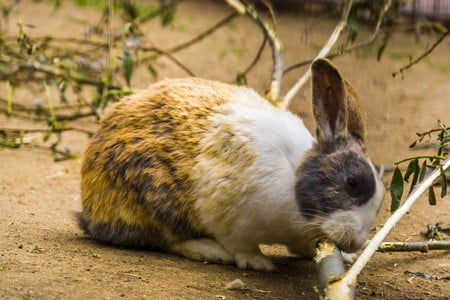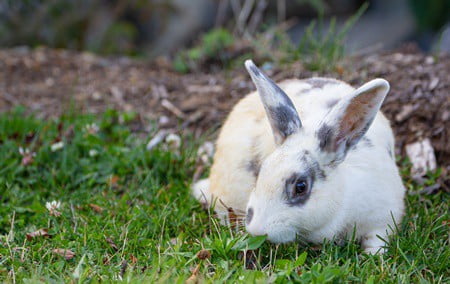Rabbits love chewing. From hay to furniture and baseboards, a rabbit will chew on anything it can get its teeth into. In addition to hay and crunchy vegetables, branches may seem like a good natural choice for gnawing. But are all types of branches rabbit-safe?
Some branches, such as apple, sycamore, cotton and pear trees are safe for rabbits to chew on. Apricot and peach tree branches are safe only after they have been dried for a month. Cedar, rose, oak, olive, fig, and citrus fruit branches are toxic for rabbits.
Because your rabbit’s teeth are constantly growing, it needs chewables, such as hay, chewing toys, and branches. Remember that each rabbit has its own personality, so you may have to experiment with different varieties of branches to determine what type your rabbit enjoys the most.
Safe Vs. Unsafe Branches for Rabbits
When evaluating wood for your rabbit, keep in mind that wood from most fruit trees is safe for rabbits to chew.
The exception to the rule are branches from trees that produce fruit with a solid pit (cherry, peaches, plum, apricot, etc.). Even though the fruit may be safe for consumption, the branches can be toxic for rabbits.
If you are not sure about the type of branches that are safe for your rabbits, look for wood marketed for rodents. These types of wood are often safe for rabbits as well.
The following types of branches are considered safe for rabbits to chew:
- Alfalfa
- Apple Wood
- Apricot (safe when dried for at least one month)
- Arbutus
- Ash
- Aspen
- Bamboo cane
- Blackberry
- Blackcurrant
- Borage
- Cholla
- Cottonwood
- Crabapple
- Dogwood
- Grapevine
- Hackberry
- Hazelnut
- Kiwi
- Kudzu
- Manzanita
- Maple (sugar and silver)
- Mesquite
- Peach (Safe when dried for at least one month)
- Pear
- Pecan
- Pine (Kiln-Dried White)
- Poplar
- Sycamore
- Willow
However, the branches listed below are deemed unsafe:
- Alder
- Almond (produces cyanide)
- Apricot (toxic when freshly cut)
- Balsam Fir
- Beech
- Birch
- Black Locust
- Blackwood
- Bog Wood
- Boxwood
- Cashew
- Cedar
- Cherry
- Citrus Woods (lime, lemon, orange, grapefruit, etc.)
- Cocobolo
- Cypress (including bald cypress)
- Dahoma
- Ebony
- Elang Mukulungu
- Elderberry
- Elm
- Eucalyptus
- Fig (including cape fig)
- Fir
- Goncalo Alves
- Greenheart
- Hemlock
- Horse Chestnut
- Iroko
- Juniper
- Kapok
- Laurel
- Magnolia
- Mahogany
- Mansonia
- Maple
- Mimosa
- Mopane
- Myrtle
- Nectarine
- Oak
- Olive
- Peach (toxic when freshly cut)
- Peroba Rosa
- Pine (fresh pine is toxic)
- Plum
- Plywood
- Prune
- Quebracho
- Redwood
- Rosewood
- Satinwood
- Sassafras
- Sequoia
- Snakewood
- Spruce
- Teak
- Walnut
- Wenge
- Yew
- Yucca
- Yunnan
- Zebrawood
Branches That Rabbit Enjoy Chewing
Rabbits kept in captivity chew more than rabbits in the wild, especially when they’re bored. Providing your rabbit with branches and chew toys in a variety of textures and sizes can help relieve this boredom.
Pay attention to your rabbit’s preferences as well. Some rabbits prefer to chew, while others love to shred.
Branches in these types of wood: apple, hazel, willow, hawthorn, sycamore, and cotton are all suitable for rabbits. One of your rabbits may prefer to chew on hazel branches, while the other may enjoy heartily enjoy apple wood branches.
Rabbits are finicky and have their own personalities and preferences. Therefore, you may have to experiment a bit until you find what your rabbit enjoys the most.
Branch-chewing is also an excellent way to prevent destructive chewing (unwanted chewing of household items) among rabbits.

Branches that Harm Rabbits’ Health
Some trees and their branches are toxic to rabbits. In general, unsafe branches for rabbits often fall under the following categories:
- Stone fruit. Any type of wood that is derived from a tree bearing fruit with a stone (peach, plum, apricot, and cherry) is toxic to rabbits. However, peach and apricot branches can be made safe after being dried for at least a month. Fresh branches from peach trees are highly toxic and should be avoided.
- Branches that release phenols (cedar and pine). Phenols are chemicals that give wood their distinct smell. Phenols are toxic for rabbits and may contribute to liver disease. Pine chew treats that have been kiln-dried to remove most of the phenols are considered safe for rabbits but most vets still recommend keeping away from them.
- Cyanide-releasing wood (elder, oak and almond). Cyanide is poisonous for rabbits. Long-term exposure may lead to severe health complications and even death.
- Wood containing tannins (redwood and walnut). Tannins are harmful to rabbits and should be avoided.
Finding Good Places to Get Branches
If you are going to find some wood for your rabbit to chew on (fresh or dried), keep the following in mind:
- Do not pick fresh wood from trees or bushes in high-pollution areas, such as roads, highways, construction suites, near factories, and built-up areas of housing or industry.
- Do not pick wood from places where people walk their dogs.
- Avoid branches from trees that have been treated with pesticides. Willow is an excellent pesticide-free option for rabbits.
- Branches from a forest or a park (away from dog-walking zones) are rabbit-safe.
- Branches from pet stores marketed for rodents or rabbits are acceptable for rabbit use.
Preparing Branches for Rabbits
Fruit tree branches, such as peach and apricot branches, are poisonous when they’re attached to the tree or fresh. However, they can be given to rabbits after they’ve been cut and dried for at least a month.
You’ll also want to make sure that the branches are cleaned thoroughly before being given to your rabbits. Here’s how:
- Remove any loose materials, such as ivy or moss
- Remove any bugs (dead and alive)
- Give the branches a good wash
- Allow the branches to dry
- Break the branches into smaller pieces
If the branches are too thin, try bunching them together and placing them inside a toilet roll tube to make a fun toy for your rabbit.
Chewing Branches Prevents Overgrown Teeth
There’s a biological reason that makes rabbits incessant gnawers. Rabbit teeth grow continually (approximately 2 mm per week), throughout their entire lifespan.
Herbivores, such as rabbits have long hypsodont teeth. Such teeth have high crowns and enamels that extend past the gumline.
Chewing on fibrous plant-materials, such as branches, stimulates a natural grinding action of the teeth. This wears down the rabbit’s teeth, keeping them at an ideal length.
However, domestic rabbits should have their teeth checked and manually cut regularly as recommended by their vet.
Overgrown Incisors
Although many of a rabbit’s teeth can overgrow, the incisors are the easiest to detect when they’ve grown uncontrollably.
Rabbit incisors that are too long will begin to curve and stick out between a rabbit’s lips. This can cause them to get stuck on objects (like cage bars) and even grow into your rabbit’s gums.
Overgrown Molars
Rabbit molars can also grow excessively, but overgrown molars are hard to identify and should be checked by a vet.
Rabbits with overgrown molars will drool excessively and have difficulty swallowing and chewing.
What You Need to Do
Not paying attention to your rabbit’s teeth can lead to severe trauma, anorexia (from poor appetite) and death from not being able to chew or swallow. To prevent conditions associated with overgrown teeth, you must:
- Provide your rabbit with a diet that’s rich in fiber, from hay, safe branches and twigs, and leafy vegetables, such as kale.
- Provide safe objects for your rabbit to chew. Branches from apple, pear, sycamore and cotton plants and trees are all good.

Other Health Benefits of Branch-Chewing for Rabbits
Chewing on rabbit-safe branches can keep your rabbit mentally and physically stimulated.
Some rabbits kept in captivity mainly chew on things because they have nothing else to do. If a rabbit spends too much time alone or isn’t given enough mental stimulation, it will chew to entertain itself or get attention from its owner.
It’s recommended that you give your rabbit a combination of twigs, branches and chew toys to chew on once in a while.
Remember that young rabbits and rabbits that haven’t been spayed or neutered will want to chew more so you’ll want to provide them with a variety of safe branches to chew on.
A spayed or neutered rabbit will chew less as it matures or as rides out the high-energy stage of its life.
Branches are High in Fiber
Branches and twigs don’t only help keep your rabbit’s teeth short, they also require to be chewed slowly which encourages proper salivation. This helps them digest their food better and aids in the release of nutrients from the fiber they consume.
Branches also provide fiber that helps keep a rabbit’s digestive system in check. They’re also incredibly nutritious for rabbits and help relieve gastric issues, GI stasis, constipation, and loose stools.
Chewing Branches and Your Rabbit’s Personality
You may have noticed that some rabbits prefer chewing on branches (or other objects), compared to other rabbits.
Experts believe that rabbits that enjoy chewing are often more outgoing, intelligent, and affectionate. They also love getting plenty of attention, while appreciating being in charge.
Some owners choose discipline (for e.g. saying “no”) to stop destructive chewing behaviors in rabbits.
Positive reinforcement and offering safer distractions, such as toys and branches that are safe for chewing is a much better solution.
Anything that keeps your rabbit entertained will keep it away from things it shouldn’t be gnawing at (such as electrical cords or furniture).


My 3 bunnies love apple branches cut fresh from our trees. But can they eat too much? I was shocked to find not only the bark stripped (as usual) but the entire branch was gone…eaten! Is it OK for them to actually eat all that wood, and if so how much is too much?
I was wondering the same thing. My neighbor brought giant branches. Like he ate a whole tree.